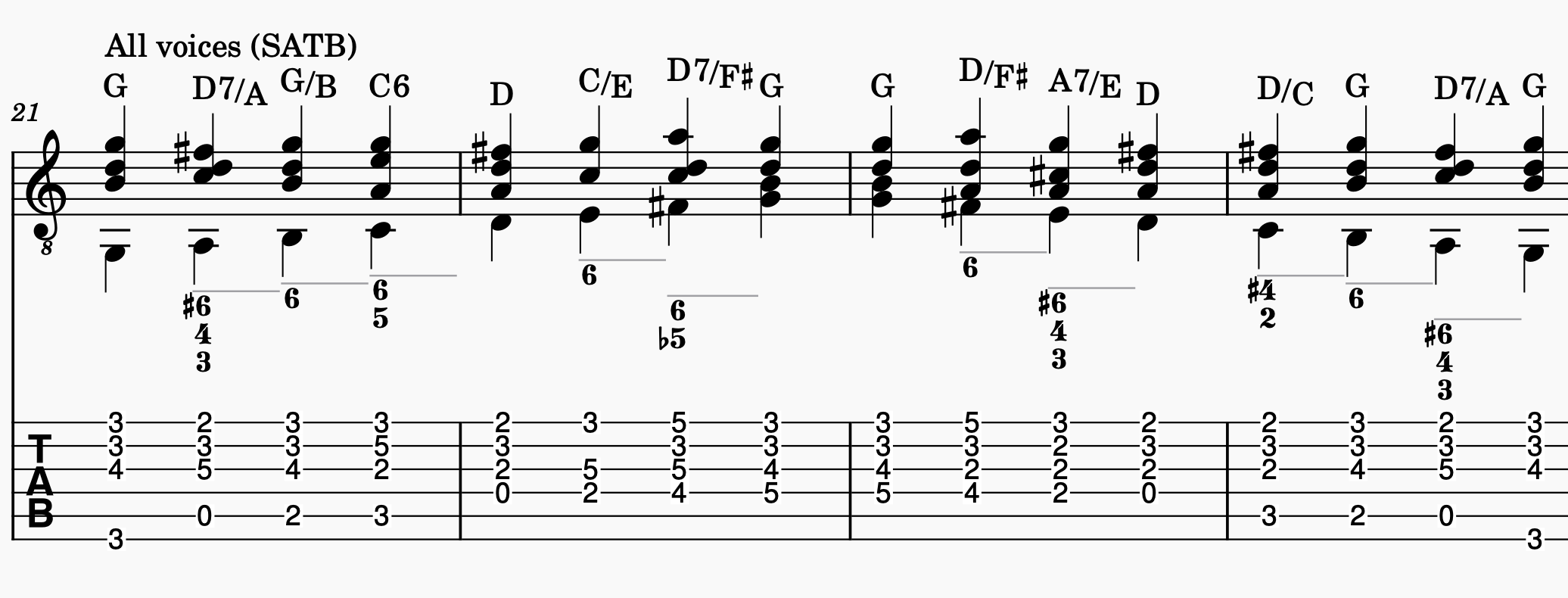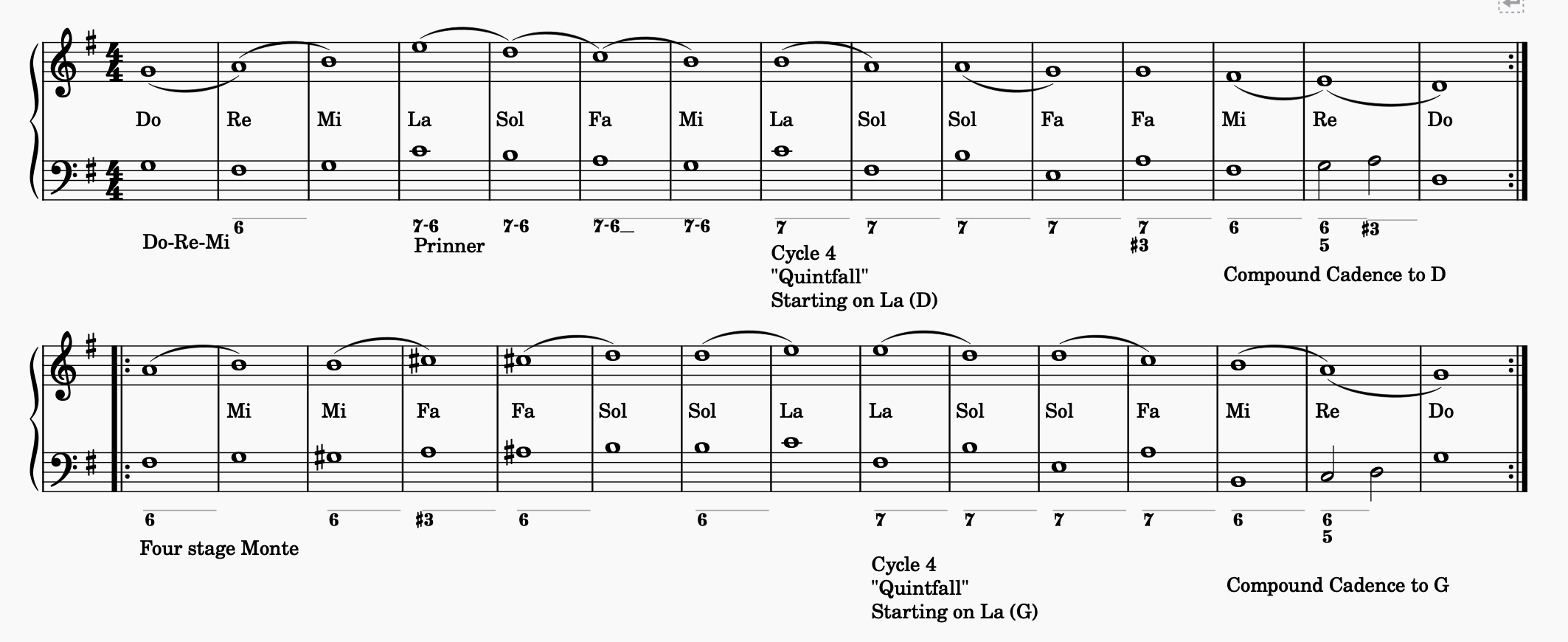
-

Excuse the formatting…
This the rule of the octave - sort of ‘classical harmony in a can’, where standard chords are associated with scale degrees in the bass. This is a concept that originated possibly on lute afaik, with it featured in an early c18 treatise by Francois Campion (1716 I think.) it also features in Rameau’s influential treatise on harmony (1730).
there’s many versions of this idea as you can imagine. It’s also fun to invent modern or jazz versions of this rule. Isaac Raz, a keen partimento enjoyer, has pointed out similarities with Barry Harris’s scale of chords. (Apparently according to Isaac, Barry himself was impressed by partimento.)
what’s slightly different here (in the pdf) is I’m building it this up from individual lines - the top notes of the Fenaroli RO positions as it happens. This works out to have some incomplete voicings, but this is fine. These are manageable on the guitar and should be transposed to various keys. The three voice variants are especially practical.
The dodgy counterpoint (there’s a parallel fifth between the upper parts on degrees 6 and 7 in some versions) is actually quite authentic to the sources. Partimentisti are much more relaxed about this sort of thing than I would have expected…. As Sanguinetti himself put it ‘who cares?’ haha.
Scholars differ on how important RO was to the study of composition; some say the RO is something more associated with a decline in the quality of students in the Neapolitan conservatoires during the later C18 (for various reasons) a ‘cheat sheet’ for poor students perhaps. Modern day teachers also vary in how important they regard it, with John Mortensen placing it at the centre of his teaching and (excellent) books, while others such as Ewald Demeyre and Michael Koch emphasise other things.Otoh the CPE Bach treatise contains many beautiful variations of the concept, and it’s certainly fun and useful to play with. Although full RO scales are rare in real c18 music, there are many instances of sections of them in music and it’s fun to look out for them.
Last edited by Christian Miller; 08-24-2023 at 06:37 AM.
-
-
Is that more as a textural distinction?
It definitely is.
I really enjoy playing baroque flute as an amateur and I think Telemann's flute fantasias can be a great example of harmonic realized on solo instrument. They are simpler than Bach's solo music and show all the possibilities with taste and grace.
-
Here's a more n00b friendly version of the Rule of the Octave. Proof reading welcome... ;-)
There shouldn't be egregious counterpoint or unplayable fingerings in this document - that'd be a mistake....
Lesson 2: The Rule of the Octave!

What is it?
· The rule of the octave (RO) is a set of pre-baked chord changes on a scale bass.
· There are many different variations. This one was the one in use with our friend Fedele Fenaroli during the later 18th century.
· We have records of WA Mozart teaching this idea, and CPE Bach has many examples in his treatise on keyboard playing. JP Rameau also discusses the concept in his influential book on harmony.
· This is an example in G major, ascending and descending.
A few notes…
· I have given the bass line with both modern chord symbols and figures (note the figures indicated # and b intervals sometimes EVEN when not required by the key signature. This is trying to teach us something. :-))
· On the next page I will give three different ‘positions’ according with which interval of the first chord we put in the top voice. So first position features of the octave, second position the third, and third position the fifth.
· The top voice doesn’t move much, and starts and finishes on the same pitch.
· The voicing of these chords is based on strong counterpoint. If you look closely, each is an inversion of the other in the upper three voices .
· One or more of these voices can be left out and the counterpoint will still be strong
· The last variant is one with parallel tenths in the outer voices. I find this one very useful.
What do we do with it?
Memorise this bad boy
· Make music!
· Try arpeggiating the chords to make a prelude texture.
· Use them as the accompaniment to simple melodies (like Twinkle Twinkle.)
· Try mixing up positions – on their own the positions are quite melodically bland but in combination can lead to attractive results.
· Don’t use the whole RO – you can use a fragment, which is usual for actual C18 music. There are few instances of the whole scale being used.
· For example, you might see 1 up to 4 or 8 down to 5.
· Try your own voicings of these chords. Pay attention to the way the voices move,
· Combine with cadences and the 5-6 and 7-6 chains to make phrases! Try using a short RO fragment, followed by a cadence. This can be surprisingly effective in making a short musical statement.
· Plug and play in Fenaroli’s first Partimento (book 1, no1)
· Look out for RO fragments and variations in real classical music. Beg borrow and steal what you find!

Last edited by Christian Miller; 08-31-2023 at 07:47 AM.
-
I will continue posting here as if any people actually read it haha
Here's a framework for an Allemande by champion hat wearer and Internet harpsichord legend Richardus Choclearius. It's a beautiful demonstration of how far you can go with a very simple framework, mostly a scale.
The main thing here. is the solfeggio. Notice the use of hexachordal mutation - Mi to La to smoothly effect what we might call a modulation to the dominant in today's parlance. Also the use of 'Fa' to sing the #4 - solfeggio syllables are unaffected by alteration. (So we are already setting up a modulation back to G that early effectively.)
The bass (and very basic figures which would be unecessary after a while) is merely the most simple example of soewmthign that would go with the solfeggio. There would be other options. Of particular interest to jazzers might be that the La-Sol-Sol-Fa-Fa melody goes with the cycle 4 progression.
Also I've noted the Gallant Schemata below (Schemata are kind of a modern idea) as Richardus did.





 Reply With Quote
Reply With Quote







Moffa Mithra
Today, 08:31 AM in For Sale